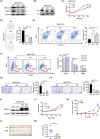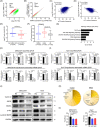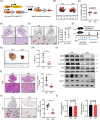METTL1 promotes hepatocarcinogenesis via m7 G tRNA modification-dependent translation control
- PMID: 34898034
- PMCID: PMC8666584
- DOI: 10.1002/ctm2.661
METTL1 promotes hepatocarcinogenesis via m7 G tRNA modification-dependent translation control
Abstract
Background: N7 -methylguanosine (m7 G) modification is one of the most common transfer RNA (tRNA) modifications in humans. The precise function and molecular mechanism of m7 G tRNA modification in hepatocellular carcinoma (HCC) remain poorly understood.
Methods: The prognostic value and expression level of m7 G tRNA methyltransferase complex components methyltransferase-like protein-1 (METTL1) and WD repeat domain 4 (WDR4) in HCC were evaluated using clinical samples and TCGA data. The biological functions and mechanisms of m7 G tRNA modification in HCC progression were studied in vitro and in vivo using cell culture, xenograft model, knockin and knockout mouse models. The m7 G reduction and cleavage sequencing (TRAC-seq), polysome profiling and polyribosome-associated mRNA sequencing methods were used to study the levels of m7 G tRNA modification, tRNA expression and mRNA translation efficiency.
Results: The levels of METTL1 and WDR4 are elevated in HCC and associated with advanced tumour stages and poor patient survival. Functionally, silencing METTL1 or WDR4 inhibits HCC cell proliferation, migration and invasion, while forced expression of wild-type METTL1 but not its catalytic dead mutant promotes HCC progression. Knockdown of METTL1 reduces m7 G tRNA modification and decreases m7 G-modified tRNA expression in HCC cells. Mechanistically, METTL1-mediated tRNA m7 G modification promotes the translation of target mRNAs with higher frequencies of m7 G-related codons. Furthermore, in vivo studies with Mettl1 knockin and conditional knockout mice reveal the essential physiological function of Mettl1 in hepatocarcinogenesis using hydrodynamics transfection HCC model.
Conclusions: Our work reveals new insights into the role of the misregulated tRNA modifications in liver cancer and provides molecular basis for HCC diagnosis and treatment.
Keywords: N7-methylguanosine; hepatocellular carcinoma; tRNA modifications; translation control; tumour progression.
© 2021 The Authors. Clinical and Translational Medicine published by John Wiley & Sons Australia, Ltd on behalf of Shanghai Institute of Clinical Bioinformatics.
Conflict of interest statement
The authors have declared that no conflict of interest exists.
Figures







References
-
- Bray F, Ferlay J, Soerjomataram I, et al. Global cancer statistics 2018: GLOBOCAN estimates of incidence and mortality worldwide for 36 cancers in 185 countries. CA Cancer J Clin. 2018;68:394‐424. - PubMed
-
- Villanueva A. Hepatocellular carcinoma. N Engl J Med. 2019;380:1450‐1462. - PubMed
-
- Lee DH, Lee JM, Lee JY, et al. Radiofrequency ablation of hepatocellular carcinoma as first‐line treatment: long‐term results and prognostic factors in 162 patients with cirrhosis. Radiology. 2014;270:900‐909. - PubMed
-
- Roayaie S, Jibara G, Tabrizian P, et al. The role of hepatic resection in the treatment of hepatocellular cancer. Hepatology. 2015;62:440‐451. - PubMed
-
- Dawson MA, Kouzarides T. Cancer epigenetics: from mechanism to therapy. Cell. 2012;150:12‐27. - PubMed
Publication types
MeSH terms
Substances
Grants and funding
LinkOut - more resources
Full Text Sources
Other Literature Sources
Research Materials
